Radish And Its Nutritional Facts And Health Benefits
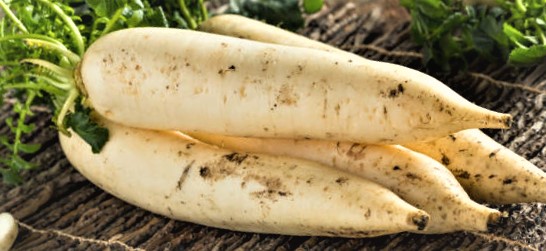 |
| Radish |
Radish
A Greek word derived from Latin came into our language, like radish. Radish or white radish or winter radish is the root of a plant used as a vegetable. Radish is a well-known common root with which like everyone, young and old, is familiar. It is usually white but also red and light green. There are two types. One long and the other round.
Radish is eaten as a raw salad like turnip and is also used as a vegetable. It is usually white in color. Cultivated in most parts of Asia and Africa. His homeland is roughly Japan, so he is also called Japanese radish. Vitamin J is a for its good amount of jam. It is thus known as a herbaceous plant whose roots are part of the human diet in many countries.
The scientific name of this plant belongs to the family Brassicaceae, also known as cruciferous. It has large leaves, flowers that are usually yellow or white, a trunk that can measure about 80 centimeters, and a fleshy root that can vary in color depending on the type of plant. Due to its importance in food and its ability to adapt, radish or radishes are cultivated all over the world.
Radish is usually eaten raw as part of a salad. Like radishes, the roots can be white, red, or black. Radish is low in calories, a feature that allows it to add to a variety of diets for weight loss purposes. Radish temper is hot and dry. Its warmth gives it a special and recognizable taste.
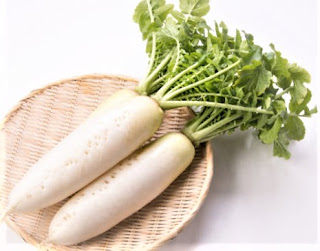 |
| Radish |
All you have to do is putting 100 grams of radish in a liter of warm water and add honey to give it a sweet taste and as a result, you get the benefits. It has been recommended to drink more than once a day until you notice significant improvement.
As if that weren't enough, radish also helped treat liver problems, kidney stones, dyspepsia (a digestive problem characterized by symptoms such as abdominal pain, heartburn, nausea, and vomiting), parasites, and gastric diseases.
Bile, also known as cholelithiasis or cholelithiasis, especially in the gallbladder, is described as the appearance of stones in the biliary tract. Mix one radish with lemon juice and cut it into pieces and eat two of them for the first day and every two hours in the next few days can help fight this disease.
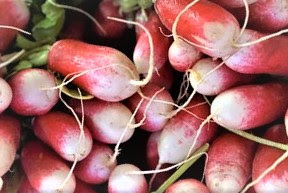 |
| Red Radish |
The most popular salad can be prepared with radish, radish and carrot salad, radish and lettuce, and salad radish and cucumber salad. Another popular recipe in some areas is radish, which contains rosemary and other spices.
Radish or Daikon
A pile of daikon radishes. Radish Plants are flowering plants. It belongs to the Brassicaceae family. The scientific name of Red radish is Raphanus sativus. Cataracts are also cured and eyesight is sharp. By eating radish. Intestinal movements are accelerated which relieves constipation.
For this, it is necessary to first rub the bald spot on the scalp with a towel and then massage it with radish juice. If radish juice is pouring into the scorpion, it dies immediately. Feeding half a towel of radish seeds with lukewarm water is useful in menopause. Radish has the following benefits.
Radish Nutrition Facts And Health Benefits
1. Treatment of jaundice and detoxification2. Osteoarthritis relief
3. Weight management
4. Heart health
5. Skin health
6. Relieves from the stones of kidney and bladder
7. For ear diseases
Nutrition Facts
One cup contains raw, chopped radishes (116 grams) contain 19 calories, 4 grams of carbohydrates, 0.8 grams of protein, 0.1 grams of fat, 1.9 grams of fiber, 17.2 mg Vitamin C 29%, 270 mg potassium 8%, 29 microgram fault 7%, 0.1 mg vitamin B6 4%, and 0.1 mg manganese 4%.
Health Benefits
1. Treatment Of Jaundice And Detoxification
Radish may be a suitable natural remedy for jaundice. In jaundice, it is beneficial to extract the juice of radish leaves and mix it with sugar. Those who use radish are less likely to get jaundice. The way to eat it is to peel and cut the radish. Add pepper and a pinch of salt and leave out overnight. Eat in the morning. It will heal in a week. The same prescription is for hemorrhoids. While jaundice is usually found only in newborns, it can actually occur in adults.
For jaundice, mixing sugar in half a cup of radish water and feeding it to a jaundiced patient can cure the disease. If you notice yellowing of the skin, mucous membranes, and whitening of the eyes, you may want to be diagnosed by your doctor. This can result in higher than normal bilirubin levels in the blood, and although it is not a disease, it can be a sign of something even more serious.
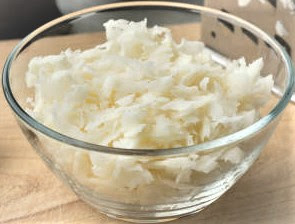 |
| Grated Radish |
2. Osteoarthritis Relief
Vitamin C is essential for the formation of collagen, which is a part of it that makes the most essential cartilage in our body. When thinking of vitamin C, we often see oranges and orange juice, but did you know that lentils are actually one of the top foods for vitamin C? Radish provides 17.2 mg per serving, which is about 29% of your daily need.
Vitamin C is an antioxidant that can help limit the damage to cartilage caused by free radicals in the body. It can help anyone diagnosed with arthritis as well as prevent it in the first place. Most important, radishes are low in calories and high in water, which makes them a great food option and useful for anyone trying to lose weight. happens.
3. Weight Management
Radishes are usually small but pack a good amount of fiber, offering a great addition to your plate. Radishes are used in a high-fiber diet and they can help regulate bowel movements, and drop constipation, this is a main cause of hemorrhoids, and radishes help lower cholesterol by binding to low-density lipoprotein. Can be found because fiber is not digested, eating foods rich in fiber can motivate you and help you avoid overeating. Most adults do not get enough fiber in their diet.
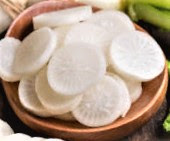 |
| Radish Slices |
4. Heart health
Radishes may help reduce the incidence of heart disease. Like most red cabbages, radishes contain a type of flavonoid called anthocyanins, the same flavonoids you find in blueberries.
According to a recent study, anthocyanins have anti-inflammatory properties that can help reduce the risk of heart disease and its effects, such as peripheral artery disease, heart failure, and even kidney disease. Anthocyanins are able to circulate metabolites, which are "products of metabolic reactions caused by various enzymes" that occur inside cells.
This process may be the one that protects against many heart problems, targeting the vascular system, reducing oxidative stress, and reducing inflammation.5. Skin health
Radish contains many nutrients, such as B vitamins, zinc, phosphorus, and vitamin C, which help to keep the skin healthy. Additionally, radish nutrition contains water, as I wrote above, providing excessive hydration for the skin.
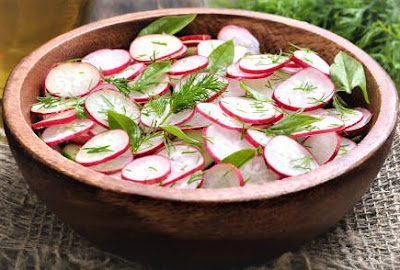 |
| Radish |
6. Relieves from the stones of kidney and bladder
In the case of stones, radishes are used in the case of sand coming from the kidney and bladder. If it is used, the stone is broken down and eliminated from the body forever. It is slow to digest but it digests food. Radish juice and radish leave in hemorrhoids Feeding heal. Chopping radish and adding salt improves the liver.
7. For ear diseases
For earache and other ear diseases. Mix an equal amount of sesame oil in radish juice and keep on low heat. When the juice burns and the oil is empty, filter it and store it in a bottle. Applying a few drops of lukewarm oil in the ears relieves ear pain and other ear ailments.
 |
| Red Radish |


.png)


.png)

.png)


Helpful
ReplyDelete